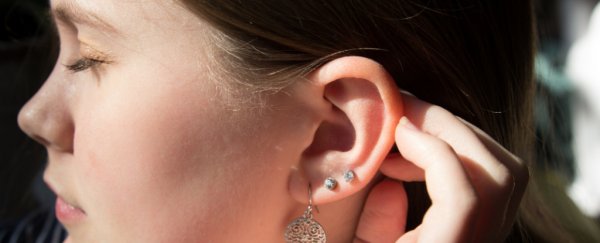Some experiences in life are hard to describe, but that doesn't make them any less real. Around the world up to 20 percent of people experience a chronic phantom ringing or buzzing in their ears, known as tinnitus.
The sounds - often high-pitched - are not connected to any known acoustic stimuli, and today, diagnosis depends solely on subjective experiences relayed by patients. Now, scientists in Australia think they have devised a method to 'see' the perception of tinnitus in the brain.
It could be the first objective clinical tool for measuring someone's tinnitus, and a step towards finding ways to treat this widespread and incurable condition.
In recent years, brain imaging studies in both animals and humans have shown tinnitus is linked to an increase in neural firing as well as changes in connectivity within certain brain regions. Still, it's only with the advent of new technology that we've come closer to a proper assessment based on this relationship.
Functional near-infrared spectroscopy (fNIRS) is a non-invasive, portable and virtually silent instrument that allows scientists to measure brain blood flow activity related to sound better than ever before.
In 2014, fNIRS was used for the first time to measure tinnitus perceptions in the brain, and the results revealed increased blood flow activity in the right auditory cortex. Further clinical research using this technology showed increased activity not just in the auditory cortex but also in nearby non-auditory regions, such as the frontal cortex and some visual processing areas.
Recently, the technology has even been used to show improved tinnitus symptoms after transcranial direct current stimulation, a potential new treatment in the works.
In 2018, scientists in Australia showed that fNIRS signals in the auditory cortex reflected both the presence and intensity of phantom sounds, indicating a valid way to measure the severity of tinnitus.
Now, an update from the same team has recorded fNIRS signals and used machine learning algorithms to classify 25 individuals with tinnitus based on the severity of their condition.
Compared to 21 healthy controls, patients with chronic ringing or buzzing in their ears showed significantly higher connectivity between temporal, frontal and occipital regions of the brain at rest.
That was enough for the machine learning algorithm to objectively measure tinnitus with an accuracy of 78 percent, according to probability analysis. What's more, the algorithm was able to differentiate between severities of tinnitus with an accuracy of 87 percent.
Similar to previous research, the imaging showed higher connectivity in the temporal-frontal lobe, which is attributed to tinnitus duration and stress, and higher connectivity in the temporal-occipital lobe, which is somehow connected to the intensity of the sound.
This suggests both the loudness and annoyance of tinnitus can be measured separately in the brain. It also supports preliminary research which shows the perceived loudness of tinnitus can be reduced by making the brain process multiple forms of sensory information.
When subject to auditory and visual patterns in the current study, those with tinnitus actually showed reduced brain activity.
The authors think this might be due to a suppression of neural activity from too much perceived stimuli, or a 'blood stealing' effect, where increased blood flow is sent to activated cortical regions at the expense of other adjacent regions.
"Our findings show the feasibility of using fNIRS and machine learning to develop an objective measure of tinnitus," the authors conclude.
"Such a measure would greatly benefit clinicians and patients by providing a tool to objectively assess new treatments and patients' treatment progress."
Tinnitus currently has no known cause or cure, and while there are some excellent tools that can be used to manage symptoms in some, options are limited and we really need more research to help people cope with this condition.
Among those with severe tinnitus, rates of depression and anxiety are unusually high, and the loudness of phantom noises is one of the biggest complaints.
An objective measurement may not change the reality for many patients today, but it could help those in the future get help sooner.
Plus, if we can use these aberrant brain changes to better understand the underlying mechanism behind tinnitus, we might be able to find a better way to treat it in the future.
It's not clear, for instance, why tinnitus is linked to asymmetric brain activity, although it could have to do with which sides of the body the sounds are perceived from.
It also must be noted that while the authors claim this to be an 'objective' clinical measurement, subjective ratings of tinnitus still had to be used to split patients into groups and compare their brain activity to perceived severity.
"Tinnitus by nature will always have a subjective component" the authors admit, but they say the current measure is the most objective we've got.
The study was published in PLOS One.
